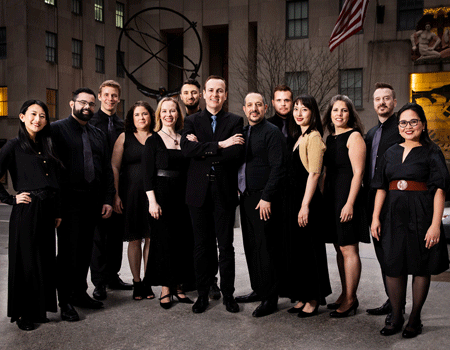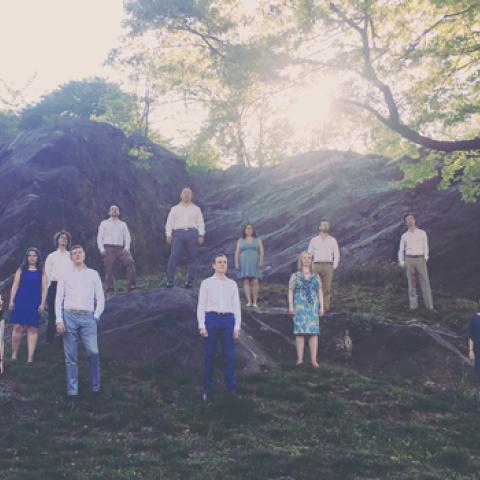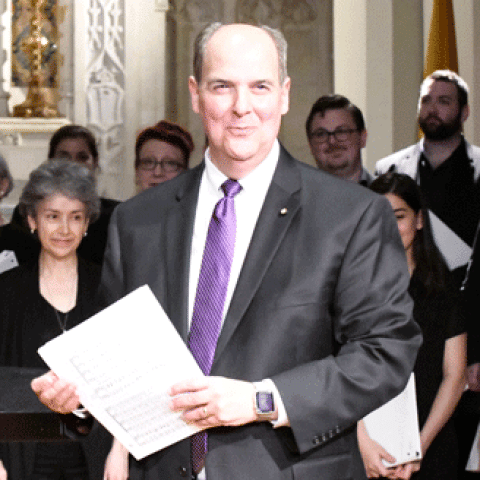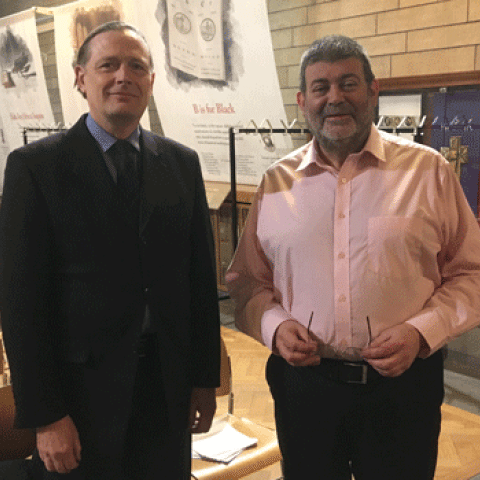The Marcussen organ in Wiedemann Hall—The vision realized
In 1956, Walter J. Duerksen, dean of the College of Fine Arts, and Gordon B. Terwilliger, graduate coordinator for the School of Music at the then University of Wichita, envisioned the installation of a three-manual organ in the recently completed Duerksen Fine Arts Center’s Miller Concert Hall as the pièce de resistance for that attractive and functional building. Although a fund was started for this purpose, other considerations intervened, and in 1964 Dean Duerksen instead decided to use the fund for the installation of an 18-rank Casavant organ (voiced by Lawrence Phelps, then at Casavant) in the new Grace Memorial Chapel.
However, the dream of an organ for Duerksen Fine Arts Center persisted. Terwilliger, who had become dean of fine arts, invited organ builder Lawrence Phelps, who then had his own firm in Erie, Pennsylvania, to the campus in 1975 to discuss whether or not the installation of a pipe organ was feasible in Miller Concert Hall. By this time, nearly twenty years after its completion, the building had limitations that precluded the successful installation of any fine organ. Phelps reported that a new building was needed. Such a prospect seemed hopeless—or decades away.
However, the extraordinary achievements of many Wichita State organ students of that time—thirty-five students in 1965—kept the vision alive. Some reason for optimism occurred in 1979, when an organ recital hall was added to a long list of university building needs and again in 1981, when it was moved to a top-priority status.
Robert Town, associate professor of organ, was encouraged enough to consult Lawrence Phelps, who suggested shapes and dimensions for the proposed building. Also, President Clark D. Ahlberg began soliciting municipal support for what had become a most ambitious vision. By 1982 Town felt that university planning and funding were progressing well enough for him to contact nine organbuilders, both American and European, regarding an estimate and preliminary stoplist for an organ with mechanical key action.
Community philanthropist and music-lover Gladys H. G. Wiedemann was one of those who believed the dream could become reality. In 1983, as president of the K. T. Wiedemann Foundation, Inc., she pledged $500,000 for the purchase of the recital hall organ. Her single generous act provided the impetus necessary to carry the project forward. University President Warren B. Armstrong reaffirmed the plan; Mrs. Rie Bloomfield, through the Sam and Rie Bloomfield Foundation, pledged $150,000 toward the building; the Wichita State University Board of Trustees guaranteed the remainder of the financing; and contracts were signed with the local architectural firm of Schaefer, Johnson, Cox, and Frey Associates, and with organbuilders Marcussen & Søn of Aabenraa, Denmark.
S. J. Zachariassen (great-great-great grandson of the founder) of Marcussen & Søn, Kansas City acoustical consultant Robert Coffeen, the architects, and the university organ committee met in Wichita to meticulously collaborate on the building and organ dynamics. The final design of the organ and the stoplist was drawn up by Robert Town and Zachariassen, with suggestions from Lawrence Phelps and renowned concert organist Gillian Weir.
The firm of E. W. Johnson and Son began construction of Wiedemann Hall in December 1984; it was finished in the spring of 1986. Of neoclassic design, this glorious building houses a main auditorium which is 100 feet long and 40 feet high, has slightly fanned side walls, and originally sat 425 people. (In 2014, all the seats were replaced to adhere to accessibility concerns. As a result, there are now 412 seats, including twelve accessible ones.)
Neither effort nor expense was spared to ensure the ideal acoustical setting for the great Marcussen organ, the first of three installed in North America by the respected now 216-year-old firm. The auditorium walls are 26 inches thick, and the stage wings are of oak paneling. The side and rear walls are made of sealed plaster and are fitted from top to bottom with sound-diffusing panels; the ceiling’s irregularly shaped forms serve the same purpose. The seating’s terraced floor is made of glazed concrete. Two aisles are carpeted, and the stage floor, steps, and apron are of oak parquet. The result is three seconds of reverberation time. The vision, the years of hoping and planning, and the generosity and efforts of many culminated in this crucial measure of success for Wiedemann Hall.
The Marcussen organ itself is no less impressive. Entering the hall, one is immediately struck by the harmonious and grandiose focal point the organ represents at the bottom of the auditorium seats. Its case is 34 feet high, 25 feet wide, and seven feet deep, made of European white oak. The console is made of exclusive palisander, also known as Brazilian rosewood. Console measurements are a modified American Guild of Organists standard, and the tuning is in equal temperament. It took five highly skilled workers from the Marcussen firm seven weeks in 1986 to install the organ; ten more weeks were required for the voicing, which was directed by Olav S. Oussoren and his assistant, Emil Bladt.
The naturals of the organ’s manual keys are ivory covered, the sharps, ebony. The organ has three pedals: a crescendo pedal; a mechanical swell pedal, which operates vertical shutters across the entire front and top of the Swell case; and a third pedal, which mechanically opens and closes the Brustwerk doors. The pedal keys are oak, the sharps ebony capped. The stopknobs are made of rosewood, and their stems are brass. The pedal combinations are brass tongues. Upgrading the original combination action of 16 generals, Solid State Organ Systems installed a new 256-series combination action in 2007.
The Brustwerk is in its traditional location above the console. Above it are the Spanish Trumpet and Positiv organ. The Positiv is slightly recessed, with the 8′ Praestant in front. The Great organ is divided on either side of the Positiv, with the 8′ Prinzipal in front. In the absence of a Rückpositiv, the Positiv’s effect is nonetheless successful; its smaller-scale sound emanates from the very center, while that of the Great organ spans the entire front. At the top, the Swell organ extends forward. The pipes of the Great 8′ Hohlflöte are in front of it, and the Pedal, with the 16′ Prinzipal in front, is on the sides.
The front pipes are 75% tin, and their mouths are leafed in 23-carat gold, as are the interiors of the Spanish Trumpet’s flared resonators. The bass pipes of the 32′, 16′, and 8′ ranks are made of copper. The remaining metal pipes are made of tin and lead alloys. Except for the Brustwerk’s 8′ Holzgedackt, which is oak, all of the wood pipes are spruce. The low 12 pipes of the very large-scale 32′ Untersatz are behind the case on the back wall.
The principals are warm and of generous scales. The Great reeds are of German character; those of the Swell and the Positiv Cromorne, French. Single stops and small combinations are clear and distinct, and the full choruses and tutti are intense but never obtrusive. The organ’s very complete specification, including two individual-rank Cornets as well as one mounted Cornet, accommodates literature of all periods equally well.
The reason for the project’s success is both simple and complex: thirty years after a vision began, resourcefulness, expertise, talent, funds, and commitment coalesced on the campus of this university to create a recital hall designed especially for an organ and an organ specifically for a hall. Through Wiedemann Hall and the great Marcussen organ, the dream was realized. It is a truly magnificent accomplishment, to be enjoyed by countless numbers of music-lovers and dreamers.
The organ was dedicated by Gillian Weir in two recitals on October 2 and 6, 1986, followed by a year-long recital series, including an appearance by Catharine Crozier on March 24, 1987.
Perpetuating the dream
How to prolong, conserve, and sustain a dream? The desire for a lasting legacy, a way of serving the community and providing a particularly spectacular performance venue for the School of Music and other artists provoked the creation of two main recital series.
It is interesting to note that this beautiful setting of the organ and the building were almost entirely funded by two women—Gladys Wiedemann for the organ, and Rie Bloomfield for the lobby, its decoration, and the endowed series.
Rie Bloomfield Organ Series
After the inauguration of the organ, Rie Bloomfield visited Wichita for seven years from California, always asking my predecessor, Robert Town, to play the organ for her. Her love for this organ prompted her sizeable gift in 1994 of $200,000 to endow a new recital series for the great Marcussen organ in Wiedemann Hall, baptized the “Rie Bloomfield Organ Series.” Artists of national and international importance have given of their brilliant talents for over twenty-eight years.
For the first twelve years, artists signed a panel in the back of the organ! They now sign a guest book. A feature I added some years ago is the popular “Conversation with the Artist,” during which I interview the guest organist during the concert. It gives the audience a more personal view of the artist, who shares with us details of their activities, what message to give to young organists, and program notes about the pieces they are performing.
To this day, the Sam & Rie Bloomfield Foundation has always generously supported this series without reserve. The twenty-fifth anniversary of the series, celebrated with a brilliant gala in 2021 due to covid lockdowns, was in 2019.
Wednesdays in Wiedemann
In 2007, I created the “Wednesdays in Wiedemann with Lynne Davis” organ recital series, which consists of eight half-hour recitals over two semesters, each with verbal program notes. These include Christmas and year-end Pops concerts. My desire was to give the university and Wichita community the opportunity to regularly hear and see this extraordinary hall and instrument. With the advent of YouTube and live-streaming, I started video-recording the recitals and have a list of over fifty videos on the organ channel of our WSUTV, which is accessible through www.wichita.edu/organ.
Another vital reason to create this series was to give an opportunity for organ students to perform and to invite other instrumentalists, either faculty or other School of Music students, to perform with the organ. For each performer, a great advantage is that their performance is forever archived as a live-stream recording on the School of Music’s Facebook page or on the YouTube organ channel. Thus, the organ’s vast number of musical possibilities as a supreme collaborator, accompanying in a quasi-orchestral capacity, and as a solo instrument are offered to the public, nationally and internationally thanks to the live streaming.
An active organ program
The very existence of the Marcussen and Wiedemann Hall provides a singular opportunity for organ students to develop necessary traits for a variety of jobs that are proposed today in the workplace. Not everyone will make their living as a concert artist. What are the other talents, then, that one needs to develop? Technique will always have its base in the practice of playing the piano. Virtuosity and basic organ coordination in advanced organ repertoire depends on it. But then, how does one manage an instrument that is a wind instrument and not a percussive one like the piano? Singing, voice training, being in a choir, conducting, accompanying choirs and other instruments gives the student organist ammunition to be competent in a variety of ways in their future jobs. It’s a way of creating a whole and complete method to develop his/her talents.
At Wichita State University’s School of Music, we have the necessary classes and courses to address this accession to a primary level of competence. Core courses in applied organ, organ literature and design, organ pedagogy, keyboard skills are offered for bachelor’s and master’s degrees in performance (keyboard/organ) and music education (keyboard/organ emphasis). A Performer’s Certificate is also offered, which is an ideal way of taking a year following a bachelors’ degree, before or after a master’s, or just as a way of further developing one’s performance skills.
Additionally, graduate staff assistant positions are available, offering the possibility of accompanying the major choirs at the school both on the piano and on the organ. Other performance possibilities include playing for the Wednesdays in Wiedemann series and other school of music events. The extent of community involvement, becoming well known to the greater university and city audiences is significant, and there are many church job possibilities. Scholarships are important, and we have many to offer.
Great advantages are to be had with lessons taken directly on the Marcussen with added practice time available. Development in touch (mechanical action), familiarity with the inner workings of the organ, its complex electronics, mechanics, easy access to the various divisions and their pipes, even tuning, are all addressed. One of the most significant advantages of studying on this instrument is to be able to develop a qualified and serious aptitude for registration. The organ “plays” all periods very well and can be used to hone one’s knowledge of registrations of these various periods.
Pedagogical projects range from student-teaching in area teachers’ studios to researching and putting together a complete video presentation on registration and pedal technique. In 2020, the Wichita chapter of the AGO requested such a video for their programming. Two of my students and I wrote, performed, and recorded this 1½-hour video.
Other advantages of studying here at WSU include participation in organizing the different organ events. Yes, it helps to know what to do, and how and when to do it. It’s a good apprenticeship. Greeting and getting to know distinguished guest artists as well as hearing them perform is a very big perk!
Other important ways to learn
We have had quite a few special events in the past sixteen years of my tenure here at WSU. All have involved sharing with the public in an exceptional way this grand organ in its grand hall.
RBOS Organ Day. From 2008 to 2020, we hosted an afternoon of presenting the Marcussen to local young musicians, how an organ works, lectures by Bertrand Cattiaux on the organ at Notre-Dame de Paris, guest organists performing and giving a masterclass to students.
The American Alain Festival. To celebrate the 100th anniversary of the birth of Jehan Alain in 1911, we organized a conference in 2011 with concerts of Alain’s organ, choral, piano, and chamber music, discussions, lecture presentations (Aurélie Decourt, Marie-Claire Alain’s daughter), receptions, collective meals, and a final performance on the mighty Wurlitzer at Century II by Jim Riggs.
Thirtieth anniversary of the Marcussen (1986–2016) gala. To mark this significant date, I gave a concert including the interdisciplinary participation of students from the other two schools in our College of Fine Arts—performing arts and art & design. Art & design created the special poster and made three sculptures to reflect the three movements of Jehan Alain’s Trois Danses: Joies, Deuils, Luttes (joys of life, death, struggles in life). Performing these dances with an organ on a stage gave me the possibility of choreographing these dances in an exceptional way: students from the school of performing arts and their teacher choreographed each of the movements, making the Marcussen also dance, using in a different way this extraordinary space.
Twenty-fifth anniversary of the Rie Bloomfield Organ Series (1994–2019) gala. Two illustrious graduates of WSU gave a brilliant joint concert, Brett Valliant and Tate Addis. Each performed works as soloists, gave a joint performance on piano and organ, and presented a masterclass for organ students. In each of these events, organ students played an important part in the organization and implementation of the schedule.
The future
From the early dream to present-day activities, the great Marcussen and Wiedemann Hall continue to carry on the tradition of excellence established from the beginning. The 2022–2023 season of the RBOS continues with two distinguished guest artists, the third being our very own WSU Symphony Orchestra, Mark Laycock, director, and myself in a grand concert of organ and orchestra on November 28, featuring the Poulenc and Guilmant, opus 42, organ concerti.
From May 21–25, 2023, a special opportunity for advanced organists will take place: Masterclass on the Marcussen with Lynne Davis. Limited to ten applicants and some auditors, we will take an in-depth look at French organ music, including morning sessions and afternoon lessons, as well as a participants concert at the conclusion of the class. Further details will be forthcoming, and those interested are invited to contact me directly. Following the masterclass, a Pipe Organ Encounter (POE), sponsored by the Wichita chapter of the AGO, will take place from June 25–30, 2023.
The continuous objective of shining a light on the “organ” for all to discover or to rediscover is our ongoing theme; to do our part in promoting this exquisite and complex instrument throughout the world and to train talented students to be its unique ambassadors. We are fortunate that the great Marcussen organ and Wiedemann Hall are the ideal tools to accomplish these goals.
—Lynne Davis
Robert L. Town Distinguished Professor of Organ
www.wichita.edu/organ
[email protected]
Marcussen & Søn (1986)
GREAT (Manual II)
16′ Gedacktpommer
8′ Prinzipal (in façade)
8′ Hohlfloete (in façade)
8′ Rohrgedackt
4′ Oktave
4′ Spitzfloete
2-2⁄3′ Quinte
2′ Oktave
8′ Cornet V (from f)
2′ Mixtur V–VI
2⁄3′ Zimbel III
16′ Dulzian
8′ Trompete
4′ Trompete
Chimes (25 notes)
SWELL (Manual IV, enclosed)
16′ Bourdon
8′ Salicional
8′ Voix Celeste
8′ Flute Harmonique
8′ Flute a cheminee
4′ Prestant
4′ Flute Octaviante
2-2⁄3′ Nasard
2′ Octavin
1-3⁄5′ Tierce
2′ Plein Jeu V
16′ Basson
8′ Trompette
8′ Hautbois
4′ Clairon
Tremulant
POSITIV (Manual I)
8′ Praestant (in façade)
8′ Gedackt
4′ Prinzipal
4′ Blockfloete
2-2⁄3′ Nasat
2′ Oktave
2′ Waldfloete
1-3⁄5′ Terz
1-1⁄3′ Quinte
1-1⁄3′ Scharf IV
8′ Cromorne
8′ Spanische Trompete
Zimbelstern (6 bells)
Tremulant
BRUSTWERK (Manual III, enclosed)
8′ Holzgedackt
8′ Quintadena
4′ Koppelfloete
2′ Prinzipal
2′ Gedacktfloete
1′ Siffloete
1⁄6′ Zimbel II
8′ Regal
Tremulant
PEDAL
32′ Untersatz
16′ Prinzipal (in façade)
16′ Subbass
8′ Oktave
8′ Gedackt
4′ Choralbass
4′ Rohrpfeife
2′ Nachthorn
2-2⁄3′ Mixtur V
32′ Kontra Fagott
16′ Posaune
16′ Fagott
8′ Trompete
4′ Schalmei
Couplers
Sw/Gt, Pos/Gt, Bw/Gt
Sw/Pos, Sw/Bw, Pos/Bw
Gt/Pd, Sw/Pd, Pos/Pd, Bw/Pd
Solid State Organ Systems MultiLevel Capture System, with 256 memory levels (16 generals)
Brustwerk pedal
Swell pedal
Adjustable Crescendo
Manual compass: 61 notes
Pedal compass: 32 notes
Mechanical key action
Electric stop action
65 stops, 84 ranks, 4,623 pipes
Photo credit: Jeff Tuttle and Lynne Davis






